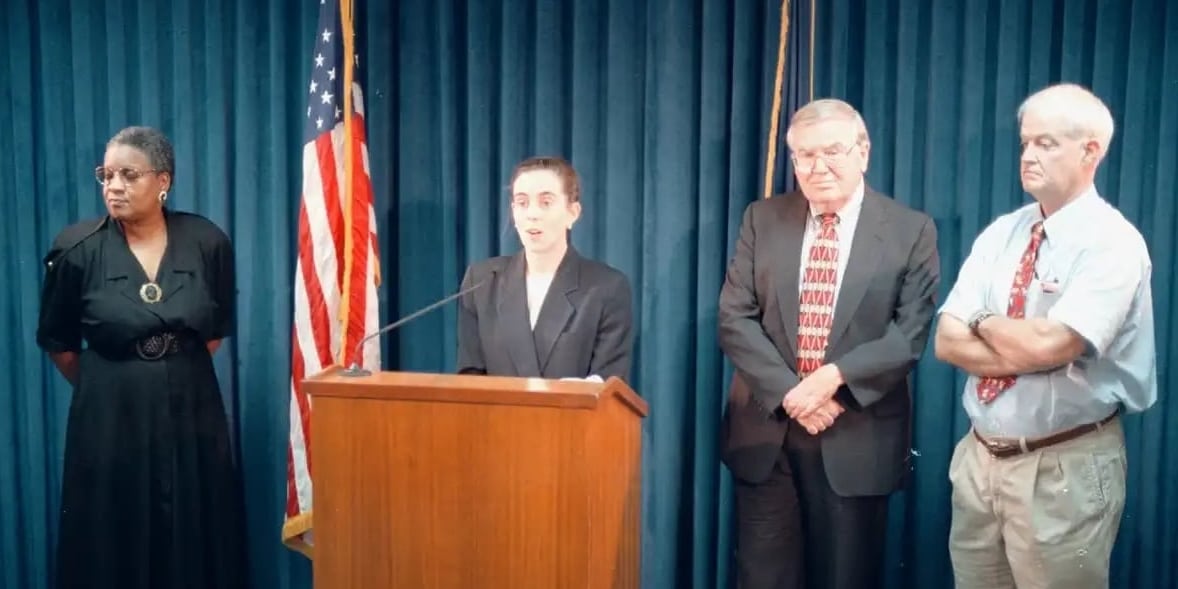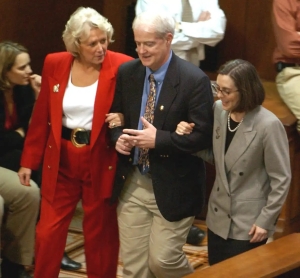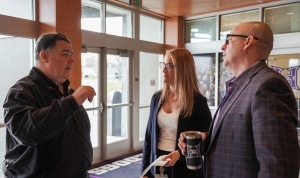How One Vote Shaped Two Remarkable Oregon Political Careers
Reflections on Kate Brown and Peter Courtney’s pursuit of the same seat during a defining moment in Oregon history
(The following is the product of interviews of over 15 former colleagues, staffers and the author’s recollections as a member of the Oregon Senate. All were part of the historic Oregon Senate sessions of 2003-2005.)
Two remarkable careers will take their final curtain call in January 2023, bringing an end to a political performance that has run on Oregon’s biggest stage for almost two decades.
Peter Courtney, a man who once proclaimed he loved the Oregon Senate more than life itself, will step down as the chamber’s longest-serving president in state history. Kate Brown, his co-star in this production, will step away from the governor’s chair she had coveted her entire political career.
That both fulfilled their ambitions against improbable odds is a story ready to be told. It is the story of how one vote changed Oregon’s political history.
—
Kate Brown entered the political arena in 1991 when she was appointed to a vacant seat in the Oregon House. She moved up the ladder quickly, jumping to the Oregon Senate in 1997. Her new Senate Democratic colleagues did not need a caucus room at the time — a broom closet could have sufficed. Republicans held a veto-proof 20-10 edge in the chamber. Brown, already gaining a reputation as a fierce political fighter, was not about to join a Democratic contingent on its way to extinction.
Ready to rally the troops like the high school cheerleader she once was (Brown demonstrated the splits on the Senate floor on her birthday just to prove she still could), she worked tirelessly on the 1998 campaigns and was rewarded by picking up three Democratic seats and the title of Senate Leader for the party. Among the newly elected senators was Peter Courtney, who had served as Democratic Leader in the House of Representatives.
Brown was only getting started on her quest for control of the Senate. She was determined to bring Democrats back to the majority and to be rewarded for the effort by becoming the chamber’s first female President.
Her focus on the Senate presidency was so pronounced that when Phil Kiesling resigned as Secretary of State in 1999, opening the job to appointment by Governor John Kitzhaber, Brown was considered among a short list for the post. When one of Brown’s confidants encouraged her to seek the appointment, the response was firm and without hesitation.
“I don’t want to be Secretary of State,” she replied. “I want to be President of the Senate.”
Under Brown’s leadership the Democrats gained another seat in the 2000 election and then, in 2002, added another to force a tie in the chamber at 15 Republicans and 15 Democrats. Brown believed her time had come.
A political tug-of-war ensued as Democrat and Republican negotiators began the process of organizing the chamber under shared leadership. Piece by piece the puzzle was snapped into place. But the grand prize — the Presidency — proved elusive.

Newly elected Senate Democratic Leader Kate Brown speaks at a press conference in 1998. She is joined by Sen. Cliff Trow, Sen. Avel Gordly, and Sen.-elect Peter Courtney. (Statesman Journal File Photo)
The topic of co-presidents was raised. Rumors began to circulate. There was speculation that Lenn Hannon, the longest-serving Republican Senator, might vote for the Democrat if he was not his party’s candidate. Another rumor was that newly-elected Democratic Senator Kurt Schrader might vote for Hannon as President if he wasn’t given the chairmanship of the powerful Ways & Means Committee. Whether either rumor had merit was inconsequential. It was enough to ratchet up the tension that continued to build.
At one point Republicans suggested a coin flip, winner take all. Senator Ginny Burdick, a member of the Democrats’ negotiating team, knew her caucus would never support that approach. But the Republicans did not know that so she decided to up the ante and call for the cards.
“OK, if we flip a coin, our candidate is Kate Brown. Who is your candidate?” Burdick said. She remembers the negotiators across the table sitting in silence, just staring at each other.
“Probably because they all wanted the job themselves,” Burdick laughed.
Republicans wanted no part of Brown as their President. They saw her as the person most responsible for stripping away their power and control in the Senate. As former Sen. Roger Beyer, a member of the Republican negotiating team put it: “It was anybody but Kate Brown.”
Without a candidate of their own, and with a 50/50 chance the face staring up at them from that coin might be Kate Brown’s, the Republicans backed away.
Weeks went by and the legislative session was on the horizon. Republicans were considering offering their newly elected caucus leader Bev Clarno as their candidate. Clarno had strong support in the caucus and had served as Speaker of the House in 1995. But there was a big problem: Republican John Minnis.
Minnis despised Clarno. The two had clashed very publicly during Clarno’s time as Speaker. Minnis told his Caucus in no uncertain terms that if Clarno was the candidate he would vote for Brown and the Democrats. They knew Minnis wasn’t bluffing. He never did. They were back to square one.
On January 13, 2003, the 72nd Legislative Assembly opened with Joan Dukes, the senior member of the Democratic caucus, in the President’s chair. She would alternate with Lenn Hannon, the senior Republican member. Republican and Democratic negotiators were meeting on the fourth floor of the Senate wing to once again try to agree on a presiding officer. Everyone else was waiting nervously in the chamber hoping for the puff of white smoke.
Clarno knew someone had to act. She had grown to admire and respect Courtney from their time as opposing leaders in the Oregon House.
“I trusted Peter. I knew he would put the institution of the Senate above politics and felt many of my colleagues probably felt the same way,” Clarno recalled.
With all other options exhausted after two months of trying, Clarno decided to pursue a different path. She surveyed her caucus on the question of whether they would support Courtney as President. The answer returned was a resounding “Yes.”
On the second morning of session, negotiators resumed their talks. Clarno announced to her Democratic counterparts that the Republicans would give the Democrats the Senate Presidency and cast a unanimous vote for their nominee, as long as that nominee was Courtney.
It had to be a gut punch for Brown. She had realized her goal of achieving the presidency for the Democrats, but only if she surrendered her claim to the gavel. With her dream shattered, she graciously stepped aside. The die had been cast. Courtney would be the next President of the Oregon Senate.
Negotiators left the fourth floor to spread the news to their members. Burdick opted to take the back stairwell and there she encountered Brown. They stood there, tears starting to well up in their eyes. Words were insufficient and unnecessary. They simply embraced and, for a few moments, just stood together and cried.
Courtney was in his Senate office at about 10 that morning when there was a knock at the door.
“It was Kate,” Courtney recalled. She had a solemn look on her face. “She told me, ‘Peter, you are going to be the next President of the Senate. Get your family on the phone and get them over here. Get your speech ready. The Chief Justice will be here at 2 p.m.”
“I was stunned. I said ‘What are you talking about?’ She said, ‘It’s settled, you’re the new Senate President.’”
The two exchanged a few words and Brown headed back towards the door. She turned back and repeated her instructions. “Get your family on the phone, now.” Then she left the room.
—
Peter Courtney had just been given the stunning news that he would be the next president of the Oregon Senate for the 2003 Session, and he had only four hours to prepare for his swearing in.
“I did not know what to do. I wasn’t prepared. I didn’t have a speech. Heck, I had no staff,” Courtney recalls.
But at 2 p.m. on January 14, Sen. Kate Brown, who had dreamed of this moment for herself, and Sen. Bev Clarno, who had put Courtney’s name into motion, escorted the Salem senator to the podium where he was sworn in by Chief Justice Wallace Carson.
In his remarks to his Senate colleagues, Courtney acknowledged his role as a relief valve after two months of intense negotiations.
“I also want to acknowledge Senator Kate Brown. We’ve been through a lot, and I know that in this audience today, each of you bring to what we’ve just done varying degrees of support and opposition. Senator Brown has acted in a way that I envy. She has shown a degree of true public service in taking herself out of a situation that she has spent so long pursuing. I hope she understands that I stand before her today as an individual who realizes that while I am the President now, I am simply a shared President.”
That last sentence would be the subject of different interpretations in the months and years ahead. Was Courtney saying that if Democrats had a clear majority, he believed Brown should be the president? Or was he trying to comfort a respected colleague who needed a word of encouragement?

Senate Republican Leader Bev Clarno and Senate Democratic Leader Kate Brown escort Sen. Peter Courtney to be sworn in at the Capitol on Jan. 14, 2003. (Statesman Journal File Photo)
During the session, the Senate operated under a memorandum of understanding that guided their bi-partisan approach to governance. When the final gavel fell later that summer, the Senate had received significant praise from colleagues, political observers, and the media for its ability to work together, and Courtney was recognized for his role in making that happen. Courtney had found his niche in the Senate he loved.
Brown, however, was making her own plans to win complete control of the Senate and take ownership of the podium. Both Brown and Courtney hit the campaign trail hard. Each understood that raising money for their candidates was a litmus test for leadership in the caucus. Each went all out in the fundraising arms race, a situation that proved stressful to lobbyists and staff of the Senate Democratic Leadership Fund. Each day that the two senators would come in to make fundraising calls they would inquire of Jack Dempsey, the executive director of the SDLF at the time, as to how much the other had raised and by whom. Lobbyists with political action committees were shaken and squeezed hard. Each senator not only wanted to extract the maximum take, but they also insisted that the money be funneled through them rather than the other so they could tally it as their contributions to the cause.
On election night, the work paid off. Not only did the Democrats win the majority, but they also gained a super majority at 18-12 for the 2005 session.
Days after the election, the Senate Democrats gathered at Salishan on the Oregon Coast to select their new leadership team. Courtney had performed admirably during the previous session, but now, with the Democrats in control and without the need to court Republican support, Brown believed it was her turn to lead the chamber. In a seven-year struggle, she had helped turn the Democratic caucus from pauper to prince.
As majority leader, Brown had earned the respect of her caucus. As president in a divided Senate, Courtney had earned their trust. The two candidates made their pitch to their colleagues and were dismissed from the room. Each member scribbled their vote on a piece of paper and tossed it into a bowl. The votes were pulled, one by one, and the names called out. Eight of their caucus members voted for Brown, eight voted for Courtney. A second round of voting was undertaken and when called out again, the two were still in a dead heat.
The tension in the room was palpable. Sen. Vicki Walker summed it up best when she said something like: “Come on people. How are we going to show we can govern the state if we can’t decide how to govern ourselves.” A third vote was cast, and this time one senator changed their vote from Brown to Courtney and the deadlock was broken. By the narrowest of margins, Peter Courtney would be retained. He would never be seriously challenged again.
—
For Brown, it was time to take stock of her political career. The Senate presidency would not be the platform from which she could launch into the Governor’s office. Bill Bradbury, however, would be finishing his second term in the Secretary of State’s office in just two years and then, two years later, there would be an open seat for Governor. She recalculated, and reenergized.
Brown entered the race for Secretary of State in the summer of 2007 and won the Democratic primary with 51% of the vote. She went on to win the general election with that same 51%.
But if there was any consideration of seeking the Governor’s office in 2010, those thoughts were quickly dashed as former Gov. John Kitzhaber, still wildly popular in Democratic circles, announced he would seek a return tour of duty in the state capitol.
The office of Secretary of State is like a Venus fly trap for aspiring politicians. The thought of being next in line for Governor is an alluring nectar. But only once in the 163 years of statehood has an SOS, who lingered into a second term, been successful in achieving election as Governor. Bradbury would soon add to that history. He would get crushed in the Democratic Primary, losing to Kitzhaber by over 30 points. Only those who escaped the office while in their first term, when their political star was brightest, successfully made the leap.
It is fundamentally an administrative post. Signing auditors’ reports, stamping corporate bylaws, counting signatures and keeping dust out of the state archives. Policy making, the gold nuggets that attracts media attention and the wallets of political funders, is left behind and a new collection of stars began to shine. By 2014 Ted Wheeler was emerging as the new Democratic wunderkind. Tina Kotek and Jennifer Williamson had also grabbed starring roles. Brown risked becoming an asterisk on the Democratic lineup card. A political career is like riding an escalator on the way up, but often an elevator on the way down.
That’s when fickle fate made an improbable appearance. Gov. Kitzhaber began facing accusations that his significant other has been using her role in the Administration for personal gain. He threw up his hands and walked away, suddenly dropping Kate Brown into the Governor’s chair.
Courtney and Brown were back in the game of making policy together once again.
—
Courtney will be remembered for many things beyond just his longevity. He has championed advancements in mental health, earthquake preparedness and higher education. He also has channeled his personal experiences into his legislative advocacy, including some unusual efforts. After suffering from a severe eye disease that threatened his sight, he decided to introduce legislation to allow legally blind people to obtain driver’s licenses. His next effort — allowing the legally blind to obtain a hunting license.
He became a fashion setter long before Steve Kornacki at the ‘Big Board.’ His usual attire of khakis, blue shirt and tennis shoes is legendary. Once every year staff and colleagues would come to the capitol to mirror their president for ‘Dress like Peter Courtney Day’.
His musings from the podium were often unhinged and humorous. He loved gifts. He once gave all his colleagues a miniature covered wagon, waxing poetically that their session work was like blazing a new Oregon Trail for Oregonians. It was always about blazing some new trail. As a gift for Mother’s Day, he once bought his wife a new lawnmower. That’s Peter Courtney.
Some observers have noted the stress of an increasingly bitter political climate has worn on him. At times he seems more like Walter Matthau’s rendition of Max Goldman, than the jolly prankster of the capitol. But if he is grumpy at times, it is understandable. Institutional decorum and collegiality are important to him. He has seen that wane in recent sessions. Over the years Peter Courtney left being just the caretaker of the institution to forever becoming a part of it.
As for Brown, her first three years as Governor were challenging as she had to face a special election and then another regular election. She was hoping her final term would allow her to build upon her legacy as a policy maker on multiple fronts. Then COVID hit, and the final three years became consumed with mask mandates and unmasked criticism.
But, as Theodore Roosevelt noted, it is not the critic that counts. Not those cold and timid souls who know neither victory nor defeat. They were willing to step into the arena and spend themselves in a worthy cause.
Kate Brown and Peter Courtney both end their careers exactly where they always wanted to be, if not by the road either one had intended to travel some two decades ago. All because of one anonymous senator who on a third ballot, cast their vote to fate.







